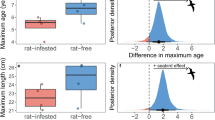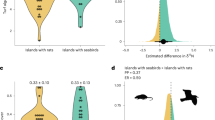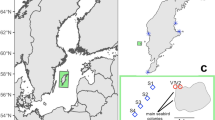Abstract
Biotic connectivity between ecosystems can provide major transport of organic matter and nutrients, influencing ecosystem structure and productivity1, yet the implications are poorly understood owing to human disruptions of natural flows2. When abundant, seabirds feeding in the open ocean transport large quantities of nutrients onto islands, enhancing the productivity of island fauna and flora3,4. Whether leaching of these nutrients back into the sea influences the productivity, structure and functioning of adjacent coral reef ecosystems is not known. Here we address this question using a rare natural experiment in the Chagos Archipelago, in which some islands are rat-infested and others are rat-free. We found that seabird densities and nitrogen deposition rates are 760 and 251 times higher, respectively, on islands where humans have not introduced rats. Consequently, rat-free islands had substantially higher nitrogen stable isotope (δ15N) values in soils and shrubs, reflecting pelagic nutrient sources. These higher values of δ15N were also apparent in macroalgae, filter-feeding sponges, turf algae and fish on adjacent coral reefs. Herbivorous damselfish on reefs adjacent to the rat-free islands grew faster, and fish communities had higher biomass across trophic feeding groups, with 48% greater overall biomass. Rates of two critical ecosystem functions, grazing and bioerosion, were 3.2 and 3.8 times higher, respectively, adjacent to rat-free islands. Collectively, these results reveal how rat introductions disrupt nutrient flows among pelagic, island and coral reef ecosystems. Thus, rat eradication on oceanic islands should be a high conservation priority as it is likely to benefit terrestrial ecosystems and enhance coral reef productivity and functioning by restoring seabird-derived nutrient subsidies from large areas of ocean.
This is a preview of subscription content, access via your institution
Access options
Access Nature and 54 other Nature Portfolio journals
Get Nature+, our best-value online-access subscription
$29.99 / 30 days
cancel any time
Subscribe to this journal
Receive 51 print issues and online access
$199.00 per year
only $3.90 per issue
Buy this article
- Purchase on Springer Link
- Instant access to full article PDF
Prices may be subject to local taxes which are calculated during checkout




Similar content being viewed by others
References
Polis, G. A., Anderson, W. B. & Holt, R. D. Toward an integration of landscape and food web ecology: the dynamics of spatially subsidized food webs. Annu. Rev. Ecol. Syst. 28, 289–316 (1997).
Doughty, C. E. et al. Global nutrient transport in a world of giants. Proc. Natl Acad. Sci. USA 113, 868–873 (2016).
Croll, D. A., Maron, J. L., Estes, J. A., Danner, E. M. & Byrd, G. V. Introduced predators transform subarctic islands from grassland to tundra. Science 307, 1959–1961 (2005).
Fukami, T. et al. Above- and below-ground impacts of introduced predators in seabird-dominated island ecosystems. Ecol. Lett. 9, 1299–1307 (2006).
Bump, J. K., Tischler, K. B., Schrank, A. J., Peterson, R. O. & Vucetich, J. A. Large herbivores and aquatic-terrestrial links in southern boreal forests. J. Anim. Ecol. 78, 338–345 (2009).
Hocking, M. D. & Reynolds, J. D. Impacts of salmon on riparian plant diversity. Science 331, 1609–1612 (2011).
Bouchard, S. S. & Bjorndal, K. A. Sea turtles as biological transporters of nutrients and energy from marine to terrestrial ecosystems. Ecology 81, 2305–2313 (2000).
Jones, H. P. et al. Severity of the effects of invasive rats on seabirds: a global review. Conserv. Biol. 22, 16–26 (2008).
Otero, X. L., De La Peña-Lastra, S., Pérez-Alberti, A., Ferreira, T. O. & Huerta-Diaz, M. A. Seabird colonies as important global drivers in the nitrogen and phosphorus cycles. Nat. Commun. 9, 246 (2018).
Polis, G. A. & Hurd, S. D. Linking marine and terrestrial food webs: allocthonous input from the ocean supports high secondary productivity on small islands and coastal land communities. Am. Nat. 147, 396–423 (1996).
McCauley, D. J. et al. From wing to wing: the persistence of long ecological interaction chains in less-disturbed ecosystems. Sci. Rep. 2, 409 (2012).
Shatova, O., Wing, S. R., Gault-Ringold, M., Wing, L. & Hoffmann, L. J. Seabird guano enhances phytoplankton production in the Southern Ocean. J. Exp. Mar. Biol. Ecol. 483, 74–87 (2016).
MacNeil, M. A. et al. Recovery potential of the world’s coral reef fishes. Nature 520, 341–344 (2015).
Carr, P. in Important Bird Areas in the United Kingdom Overseas Territories (ed. Sanders, S. M.) 37–55 (Royal Society for the Protection of Birds, Sandy, 2006).
Young, H. S., McCauley, D. J., Dunbar, R. B. & Dirzo, R. Plants cause ecosystem nutrient depletion via the interruption of bird-derived spatial subsidies. Proc. Natl Acad. Sci. USA 107, 2072–2077 (2010).
Szpak, P., Longstaffe, F. J., Millaire, J.-F. & White, C. D. Stable isotope biogeochemistry of seabird guano fertilization: results from growth chamber studies with maize (Zea mays). PLoS ONE 7, e33741 (2012).
Lorrain, A. et al. Seabirds supply nitrogen to reef-building corals on remote Pacific islets. Sci. Rep. 7, 3721 (2017).
MaMahon. K. W., Johnson, B. J., Ambrose, W. G. Ocean Ecogeochemistry: a review. Oceanogr. Mar. Biol. Annu. Rev. 51, 327–374 (2013).
Mora, C. Ecology of Fishes on Coral Reefs (Cambridge Univ. Press, Cambridge, 2015).
Bellwood, D. R., Hughes, T. P., Folke, C. & Nyström, M. Confronting the coral reef crisis. Nature 429, 827–833 (2004).
Hoey, A. S. & Bellwood, D. R. Cross-shelf variation in the role of parrotfishes on the Great Barrier Reef. Coral Reefs 27, 37–47 (2008).
Perry, C. T., Kench, P. S., O’Leary, M. J., Morgan, K. M. & Januchowski-Hartley, F. Linking reef ecology to island building: parrotfish identified as major producers of island-building sediment in the Maldives. Geology 43, 503–506 (2015).
Sheppard, C. R. C. et al. Coral bleaching and mortality in the Chagos Archipelago. Atoll Res. Bull. 613, 1–26 (2017).
Shantz, A. A. & Burkepile, D. E. Context-dependent effects of nutrient loading on the coral–algal mutualism. Ecology 95, 1995–2005 (2014).
D’Angelo, C. & Wiedenmann, J. Impacts of nutrient enrichment on coral reefs: new perspectives and implications for coastal management and reef survival. Curr. Opin. Environ. Sustain. 7, 82–93 (2014).
Graham, N. A. J., Jennings, S., MacNeil, M. A., Mouillot, D. & Wilson, S. K. Predicting climate-driven regime shifts versus rebound potential in coral reefs. Nature 518, 94–97 (2015).
Gove, J. M. et al. Near-island biological hotspots in barren ocean basins. Nature Commun. 7, 10581 (2016).
Keitt, B. et al. Best practice guidelines for rat eradication on tropical islands. Biol. Conserv. 185, 17–26 (2015).
Brooke, M. de L. et al. Seabird population changes following mammal eradications on islands. Anim. Conserv. 21, 3–12 (2018).
Hughes, T. P. et al. Spatial and temporal patterns of mass bleaching of corals in the Anthropocene. Science 359, 80–83 (2018).
Wenban-Smith, N. & Carter, M. Chagos: a History: Exploration, Exploitation, Expulsion (Chagos Conservation Trust, London, 2016).
Sheppard, C. R. C. et al. Reefs and islands of the Chagos Archipelago, Indian Ocean: why it is the world’s largest no-take marine protected area. Aquat. Conserv. 22, 232–261 (2012).
Graham, N. A. J. et al. Human disruption of coral reef trophic structure. Curr. Biol. 27, 231–236 (2017).
.Readman, J. W. et al. in Coral Reefs of the United Kingdom Overseas Territories (ed. Sheppard, C. R. C.) 283–298 (Springer, Dordrecht, 2013).
Bibby, C. J., Burgess, N. B. & Hill, D. A. Bird Census Techniques (Academic, London, 1992).
McGowan, A., Broderick, A. C. & Godley, B. J. Seabird populations of the Chagos Archipelago: an evaluation of IBA sites. Oryx 42, 424–429 (2008).
del Hoyo, J., Elliott, A., Sargatal, J., Christie, D. A. & de Juana, E. (eds) Handbook of the Birds of the World Alive (Lynx Edicions, Barcelona, 2017).
Krzywinski, M. & Altman, N. Visualizing samples with box plots. Nat. Methods 11, 119–120 (2014).
Jennings, S. & Collingridge, K. Predicting consumer biomass, size-structure, production, catch potential, responses to fishing and associated uncertainties in the world’s marine ecosystems. PLoS ONE 10, e0133794 (2015).
Aumont, O. & Bopp, L. Globalizing results from ocean in situ iron fertilization studies. Glob. Biogeochem. Cycles 20, GB2017 (2006).
Mendez, L. et al. Geographical variation in the foraging behaviour of the pantropical red-footed booby. Mar. Ecol. Prog. Ser. 568, 217–230 (2017).
Schmidtko, S., Johnson, G. C. & Lyman, J. M. MIMOC: A global monthly isopycnal upper-ocean climatology with mixed layers. J. Geophys. Res. 118, 1658–1672 (2013).
IOC, IHC, BODC. The GEBCO Digital Atlas. (BODC, 2008).
Ashmole, N. P. Body size, prey size, and ecological segregation in five sympatric tropical terns (Aves: Laridae). Syst. Zool. 17, 292–304 (1968).
Harrison, C. S., Hida, T. S. & Seki, M. P. Hawaiian seabird feeding ecology. Wildl. Monogr. 85, 3–71 (1983).
Wiebe, P. H., Boyd, S. H. & Cox, J. L. Relationships between zooplankton displacement volume, wet weight, dry weight and carbon. Fish Bull. 73, 777–786 (1975).
Jennings, S. & Cogan, S. M. Nitrogen and carbon stable isotope variation in northeast Atlantic fishes and squids. Ecology 96, 2568 (2015).
Martiny, A. C., Vrugt, J. A. & Lomas, M. W. Concentrations and ratios of particulate organic carbon, nitrogen, and phosphorus in the global ocean. Sci. Data 1, 140048 (2014).
Martiny, A. C., Vrugt, J. A., Primeau, F. W. & Lomas, M. W. Regional variation in the particulate organic carbon to nitrogen ratio in the surface ocean. Glob. Biogeochem. Cycles 27, 723–731 (2013).
Crossland, C. J., Hatcher, B. G. & Smith, S. V. Role of coral reefs in global ocean production. Coral Reefs 10, 55–64 (1991).
Hatcher, B. G. Coral reef primary productivity. A hierarchy of pattern and process. Trends Ecol. Evol. 5, 149–155 (1990).
Salvatier, J., Wiecki, T. V. & Fonnesbeck, C. Probabilistic programming in Python using PyMC3. PeerJ Comput. Sci. 2, e55 (2016).
Gelman, A. et al. Bayesian Data Analysis Vol. 2 (CRC, Boca Raton 2014).
Campana, S. E. Otolith science entering the 21st century. Mar. Freshw. Res. 56, 485–495 (2005).
Pardo, S. A., Cooper, A. B. & Dulvy, N. K. Avoiding fishy growth curves. Methods Ecol. Evol. 4, 353–360 (2013).
Wilson, S. K., Graham, N. A. J. & Polunin, N. V. C. Appraisal of visual assessments of habitat complexity and benthic composition on coral reefs. Mar. Biol. 151, 1069–1076 (2007).
Letourneur, Y. Length–weight relationships of some marine fish species in Reunion Island, Indian Ocean. Naga 21, 37–39 (1998).
Wilson, S. K. et al. Exploitation and habitat degradation as agents of change within coral reef fish communities. Glob. Chang. Biol. 14, 2796–2809 (2008).
Ong, L. & Holland, K. N. Bioerosion of coral reefs by two Hawaiian parrotfishes: species, size differences and fishery implications. Mar. Biol. 157, 1313–1323 (2010).
McDuie, F., Weeks, S. J., Miller, M. G. R. & Congdon, B. C. Breeding tropical shearwaters use distant foraging sites when self-provisioning. Mar. Ornithol. 43, 123–129 (2015).
Calabrese, L. Foraging Ecology and Breeding Biology of Wedge-Tailed Shearwater (Puffinus Pacificus) and Tropical Shearwater (Puffinus Bailloni) on Aride Island Nature Reserve, Seychelles : Tools for Conservation. PhD thesis, Université Pierre et Marie Curie-Paris VI (2015).
Pennycuick, C. J., Schaffner, F. C., Fuller, M. R., Obrecht, H. H. III & Sternberg, L. Foraging flights of the white-tailed tropicbird (Phaethon lepturus): radiotracking and doubly-labelled water. Colon. Waterbirds 13, 96–102 (1990).
Jaquemet, S., Le Corre, M., Marsac, F., Potier, M. & Weimerskirch, H. Foraging habitats of the seabird community of Europa Island (Mozambique Channel). Mar. Biol. 147, 573–582 (2005).
Gilardi, J. D. Sex-specific foraging distributions of brown boobies in the eastern tropical Pacific. Colon. Waterbirds 15, 148–151 (1992).
Weimerskirch, H., Le Corre, M., Jaquemet, S. & Marsac, F. Foraging strategy of a tropical seabird, the red-footed booby, in a dynamic marine environment. Mar. Ecol. Prog. Ser. 288, 251–261 (2005).
Surman, C. A. & Wooller, R. D. Comparative foraging ecology of five sympatric terns at a sub-tropical island in the eastern Indian Ocean. J. Zool. (Lond.) 259, 219–230 (2003).
Bourne, W. R. P. & Simmons, K. E. L. The distribution and breeding success of seabirds on and around Ascension in the tropical Atlantic Ocean. Atl. Seabirds 3, 187–202 (2001).
Dunlop, J. N. Foraging range, marine habitat and diet of bridled terns breeding in Western Australia. Corella 21, 77–82 (1997).
Hulsman, K. & Smith, G. Biology and growth of the black-naped tern (Sterna sumatrana): A hypothesis to explain the relative growth rates of inshore, offshore and pelagic feeders. Emu 88, 234–242 (1988).
Acknowledgements
This research was supported by the Australian Research Council’s Centre of Excellence Program (CE140100020), a Royal Society University Research Fellowship awarded to N.A.J.G. (UF140691), and a Tier II NSERC Canada Research Chair awarded to M.A.M. We thank the British Indian Ocean Territory section of the British Foreign and Commonwealth Office for permission to conduct the study, and J. Turner for organizing the expedition. Animal ethics for fish collection were approved by James Cook University (approval number A2166). Thanks to J. Lokrantz for graphics help with Figs. 1, 2, and J. Barlow, S. Keith, and R. Evans for comments on the manuscript.
Reviewer information
Nature thanks Y. Cherel, N. Knowlton and S. Wing for their contribution to the peer review of this work.
Author information
Authors and Affiliations
Contributions
N.A.J.G. conceived the study with S.K.W.; N.A.J.G., S.K.W. and P.C. collected the data; N.A.J.G., M.A.M., S.J. and A.S.H. developed and implemented the analyses; N.A.J.G. led the writing of the manuscript with S.K.W., M.A.M., S.J., A.S.H. and P.C.
Corresponding author
Ethics declarations
Competing interests
The authors declare no competing interests.
Additional information
Publisher’s note: Springer Nature remains neutral with regard to jurisdictional claims in published maps and institutional affiliations.
Extended data figures and tables
Extended Data Fig. 1 Primary production and potential prey biomass and production in areas accessible to seabirds foraging around the Chagos Islands.
a, Recorded foraging ranges for seabird species that feed on smaller prey (light tone, 0.1–9 g individual wet weight) or larger prey (dark tone, 1–50 g individual wet weight; broken lines indicate that greater ranges are expected for two of the species thus foraging area calculations assumed that the foraging range is the radius of the foraging area). b, Primary production in the foraging area. c, Modelled biomass. d, Production of fauna in the foraging area. Median and 90% uncertainty intervals on the basis of 10,000 simulations to assess the effects of parameter uncertainty39 on biomass or production estimates are shown. Biomass and production were estimated for fauna in the prey size ranges consumed by each bird species, and expressed as wet and nitrogen (N) weight, respectively.
Supplementary information
Rights and permissions
About this article
Cite this article
Graham, N.A.J., Wilson, S.K., Carr, P. et al. Seabirds enhance coral reef productivity and functioning in the absence of invasive rats. Nature 559, 250–253 (2018). https://doi.org/10.1038/s41586-018-0202-3
Received:
Accepted:
Published:
Issue Date:
DOI: https://doi.org/10.1038/s41586-018-0202-3
This article is cited by
-
Invasive species drive cross-ecosystem effects worldwide
Nature Ecology & Evolution (2024)
-
Integration of population genetics with oceanographic models reveals strong connectivity among coral reefs across Seychelles
Scientific Reports (2024)
-
Predation of sea turtle eggs by rats and crabs
Marine Biology (2024)
-
Seabird guano reshapes intertidal reef food web in an isolated oceanic islet
Coral Reefs (2024)
-
Exploring benthic habitat assessments on coral reefs: a comparison of direct field measurements versus remote sensing
Coral Reefs (2024)
Comments
By submitting a comment you agree to abide by our Terms and Community Guidelines. If you find something abusive or that does not comply with our terms or guidelines please flag it as inappropriate.



